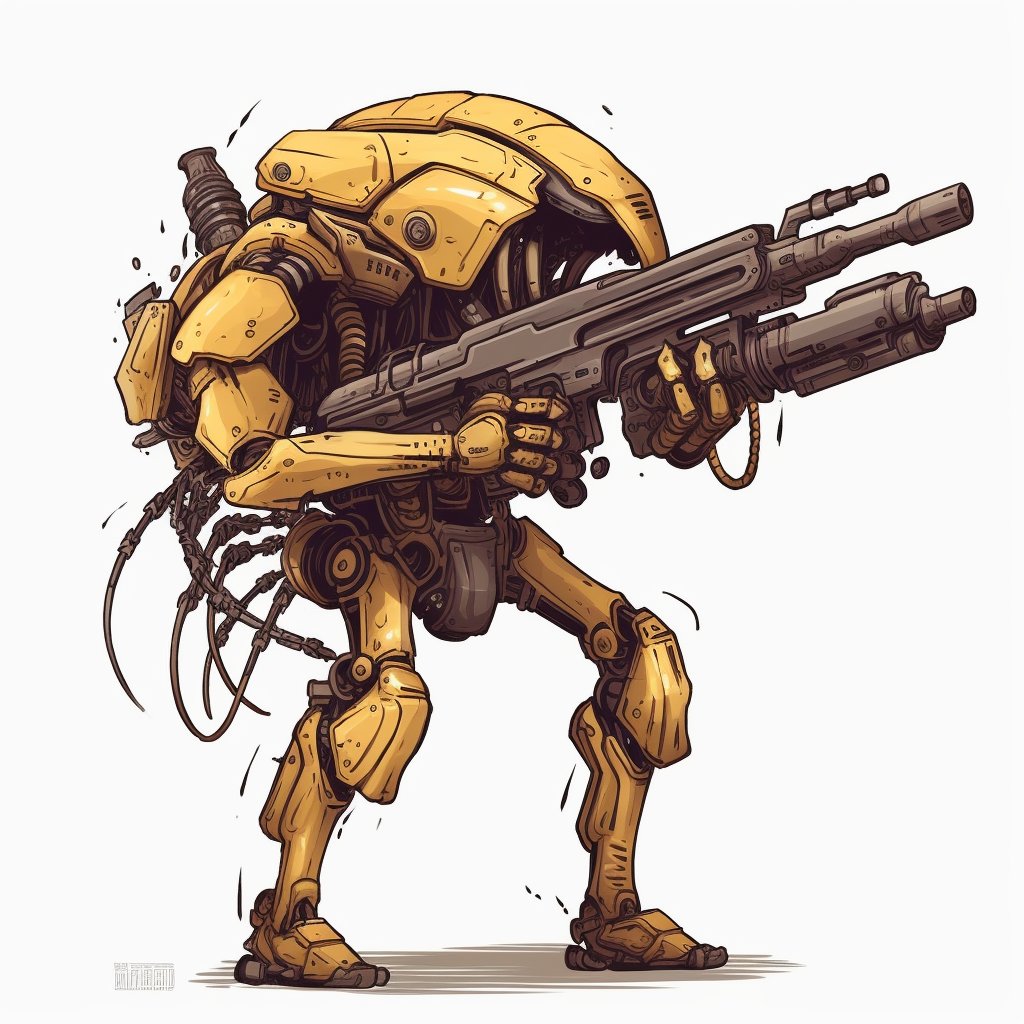Gelotto Monsters Unleashed: An NFT-Based Play-to-Earn Customizable Gaming Experience
Summary
Gelotto Monsters Unleashed is a cryptocurrency-based play-to-earn game centered around the collection and modification of virtual creatures, represented by non-fungible tokens (NFTs). Because NFTs are immutable, smart contracts and editable metadata are used to represent changeable features of a creature. The NFTs are used as an Access Control List (ACL) that limits execution of the smart contracts that change these features to wallets that own the required NFTs and meet other in-game requirements. The NFTs themselves also include data regarding a creature that is not intended to be changeable, such as its genetic lineage.
Initially, an NFT representing an "egg" is acquired by a player. The attributes of the egg NFT are represented by metadata at a location indicated in the NFT data. The attributes of the egg may be modified by using other NFTs, such as NFTs representing "potions." The attributes are modified using a smart contract that first verifies that the player owns the required NFTs and meets other in-game requirements, effectively using the NFTs as an ACL for executing the smart contract. Then, the metadata representing the attributes of the egg is updated, while the egg NFT itself remains unchanged.
The egg may be "hatched" to generate an NFT representing a "creature" having various attributes that are based on the attributes of the egg. The hatching process also utilizes a smart contract that first verifies that the player owns the required NFT and meets other in-game requirements (such as a cost or ownership of other in-game assets). The metadata associated with the egg NFT is then modified to represent attributes of a creature, while the underlying NFT remains unchanged, enabling the creature to retain the same genetic information and other immutable data stored in the NFT. The creature may be customized using other NFTs that change the name or appearance of the creature or modify the creature’s attributes. Each modification to the creature may similarly be performed using NFTs as an ACL to execute a smart contract, then modifying the associated metadata while the underlying NFT remains unchanged.
Two creature NFTs may be used to execute a breeding smart contract to produce a new egg NFT. The breeding smart contract may similarly verify ownership of the required NFTs, verify that other in-game requirements are met, then generate a new egg NFT having attributes that are determined based in part on the attributes of the selected creature NFTs. The new egg NFT will include unchangeable NFT data indicating its genetic lineage, which is determined using the genetic lineages of the creature NFTs used in the breeding process.
Creatures represented by the NFTs may be used in a variety of competitive and non-competitive tasks, such as simulated battles with other creatures, puzzles, or games, with randomly determined outcomes based in part on the attributes of the creatures. All game NFTs may be traded using NFT marketplaces.
Introduction
The gaming industry is rife with games featuring collectible cards used to participate in simulated battles or other types of gameplay, with characteristics of the collectible cards affecting game outcomes. The gaming industry also includes numerous games where outcomes of battles and other activities between characters, creatures, or avatars are determined based on the attributes of these simulated beings. Many games also feature content where a first virtual object, such as a character or creature, may be augmented or customized using other virtual objects, such as equipment or consumable items, then used to complete various game-related tasks. The cryptocurrency space has also featured such games, with NFTs representing one or more virtual objects or creatures, and in some cases with game-specific cryptocurrency tokens used to purchase NFTs or affect game outcomes.
Conventional cryptocurrency-based games of this nature often have large financial barriers to entry or may require a significant investment of time to participate in repetitive gameplay. Additionally, the immutability of data on the blockchain and the non-fungibility of NFTs may hinder the use of NFTs as representations of in-game objects that may change dynamically as a game progresses, such as creatures. For example, because an NFT is not able to be modified, various workarounds that simulate the changeability of an in-game object must be used, such as destroying (e.g., burning) and replacing an NFT on each instance that an NFT is modified, or associating NFTs with external sources of data.
Gelotto Monsters Unleashed aims to become a blockchain-based game, built within the Cosmos/Internet of Blockchains (IBC) ecosystem, that provides an engaging, sustainable, and potentially profitable experience for users while leveraging the power of NFTs and blockchain technology. Gelotto Monsters Unleashed will allow players to collect, customize, trade, and battle unique creatures from various themes, while reducing or even eliminating many barriers to entry that are present in similar games. To enable NFTs that represent creatures or eggs to be customized and improved, metadata that represents changeable attributes of a creature or egg may be modified using smart contracts. Each smart contract verifies that the player attempting to execute the contract owns the required NFTs, effectively using a collection of NFTs as an ACL for the smart contract. The NFTs themselves may remain unchanged, and may store data regarding an egg or creature that is not intended to be modified, such as the genetic lineage of the egg or creature.
Basic Game Mechanics
A game manual that includes detailed information regarding game mechanics will be published when the initial version of Gelotto Monsters Unleashed is released, and updated as different aspects of Gelotto Monsters Unleashed are added or changed. Because new content may be added and existing content may be modified frequently, many gameplay aspects may change dynamically.
Therefore, an exhaustive list of NFTs, game mechanics, and possible gameplay activities is beyond the scope of this whitepaper. However, a brief summary of basic gameplay features follows.
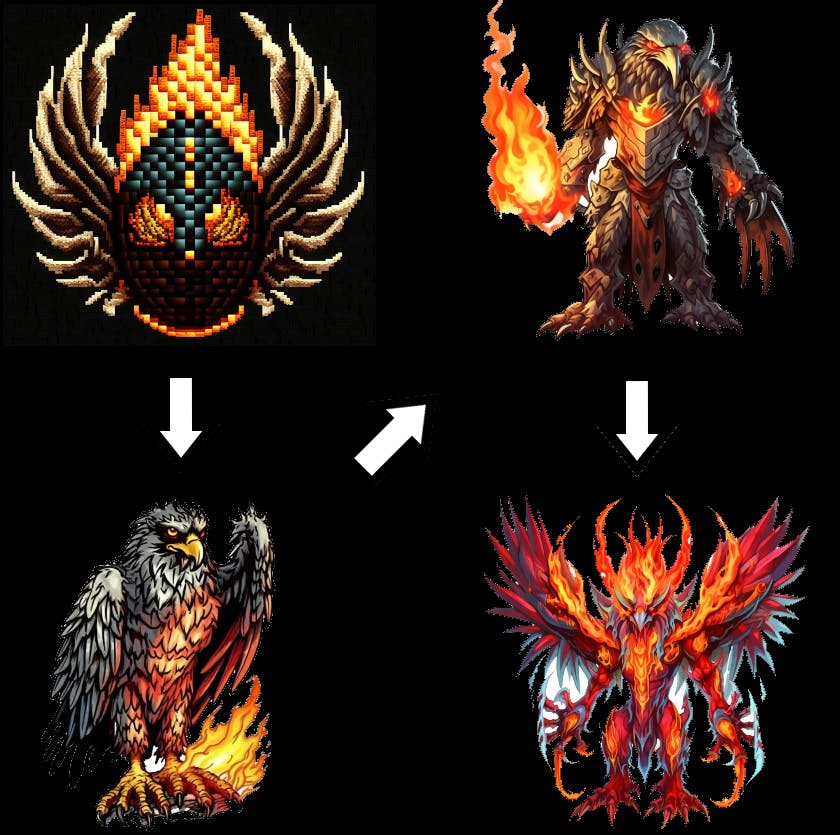
Eggs
Each creature in Gelotto Monsters Unleashed begins as an egg that can be “hatched” at a future time, generating a creature. An egg will be represented by an NFT. The NFT data for each egg NFT will primarily consist of a unique identifier used to differentiate a particular NFT from other NFTs, and a location (such as a Uniform Resource Identifier (URI)) that references a source of metadata that represents the attributes of the egg. The NFT data may also indicate the genetic lineage of the egg NFT.
Egg Attributes
The attribute metadata for an egg NFT may be changed, while the NFT data itself remains constant. Attributes indicated in the metadata for an egg NFT may include:
Appearance: The visual characteristics of the NFT
These may include a particular image, traits or colors of an image or background, or other visual characteristics intended to represent the visual appearance of the egg
Appearance characteristics may also include a name assigned to the NFT
Available appearance characteristics for a particular egg may correspond to the type of creature that will be generated when the egg is hatched, or may correspond to other attributes of the egg.
Certain types of NFTs may be used to modify the appearance characteristics of the egg NFT
Rarity value: Each egg NFT will have a value representing the rarity of the egg represented by the NFT
The rarity value for an egg will correspond to the probability that a creature NFT generated when the egg NFT is hatched will have desirable characteristics
Certain types of NFTs may be used to positively or negatively modify the rarity value associated with an egg NFT
Biases: An egg NFT may be associated with biases that affect the probability that a creature NFT generated when the egg NFT is hatched will have particular attributes
Some egg NFTs may have default biases
Certain types of NFTs may be used to add, remove, or replace biases associated with an egg NFT
Hatching timer: Each egg NFT will be associated with a hatching timer that begins to decrement when the egg NFT is minted
The egg may be hatched to generate a creature after the hatching timer has elapsed
Initial values for a hatching timer may range from 1 day to 3 years
- While not an absolute rule, longer hatching times are typically associated with egg NFTs having higher rarity values or certain biases
Certain types of NFTs may be used to positively or negatively modify the hatching timer value associated with an egg NFT
Egg Modification Process
A smart contract may be used to add, remove, modify, or replace selected portions of the metadata associated with an egg NFT
The specific attributes that are changed may depend on the attributes of an additional NFT used in the modification process
The metadata associated with the additional NFT may indicate a single attribute or multiple attributes
- Example: A potion NFT may decrease the hatching timer value for an egg but also decrease the rarity value
The metadata associated with the additional NFT may indicate probabilities of a particular modification occurring
Example: A potion NFT may have a 50% chance to increase the rarity value of an egg, a 10% chance to increase the hatching timer for the egg, and a 1% chance to destroy (e.g., burn) the egg NFT
An in-game or external source of randomness may be used to determine the specific modifications that occur
The metadata associated with the additional NFT may indicate a range of values associated with a modification
Example: A potion NFT may add or subtract a random value ranging from 1 to 4 to or from a particular attribute
An in-game or external source of randomness may be used to determine the specific values that are added or subtracted
When a user attempts to execute the smart contract using the game interface:
The smart contract verifies that the wallet requesting to execute the contract owns the egg NFT, an additional NFT to modify the attributes of the egg, and other game requirements (if applicable) such as a cost using in-game tokens or other assets
If all requirements are met, the contract is executed to modify the metadata of the egg NFT based on modifications indicated in the metadata for the additional NFT used in the modification process
See the flowchart below:

Creatures
When the hatching timer for an egg NFT has elapsed, the option to hatch the egg to generate a creature will become available.

Hatching Process
The process of hatching an egg is similar to the egg modification process outlined above:
When a user attempts to execute the smart contract using the game interface:
The smart contract verifies that:
The wallet that is requesting to execute the contract owns an egg NFT
The hatching timer value for the egg NFT has elapsed
Other in-game requirements (if applicable) are met
A set of attributes for the resulting creature NFT are determined
Attributes for the creature are based in part on the attributes of the egg
Attributes may also be based in part on an in-game or external source of randomness
Optionally, attributes may be based on external factors, such as in-game assets spent to improve the hatching process, in-game or external assets owned by the wallet requesting to execute the contract, or other factors
The attributes for the creature NFT replace the attributes for the egg NFT. Effectively, the egg NFT becomes the creature NFT and may be associated with a new image and a different set of attributes
The underlying NFT data remains unchanged and includes the same identifier, metadata location, and genetic lineage
See the flowchart below:

Creature Attributes
The attribute metadata for a creature NFT may be changed, while the NFT data itself remains constant.
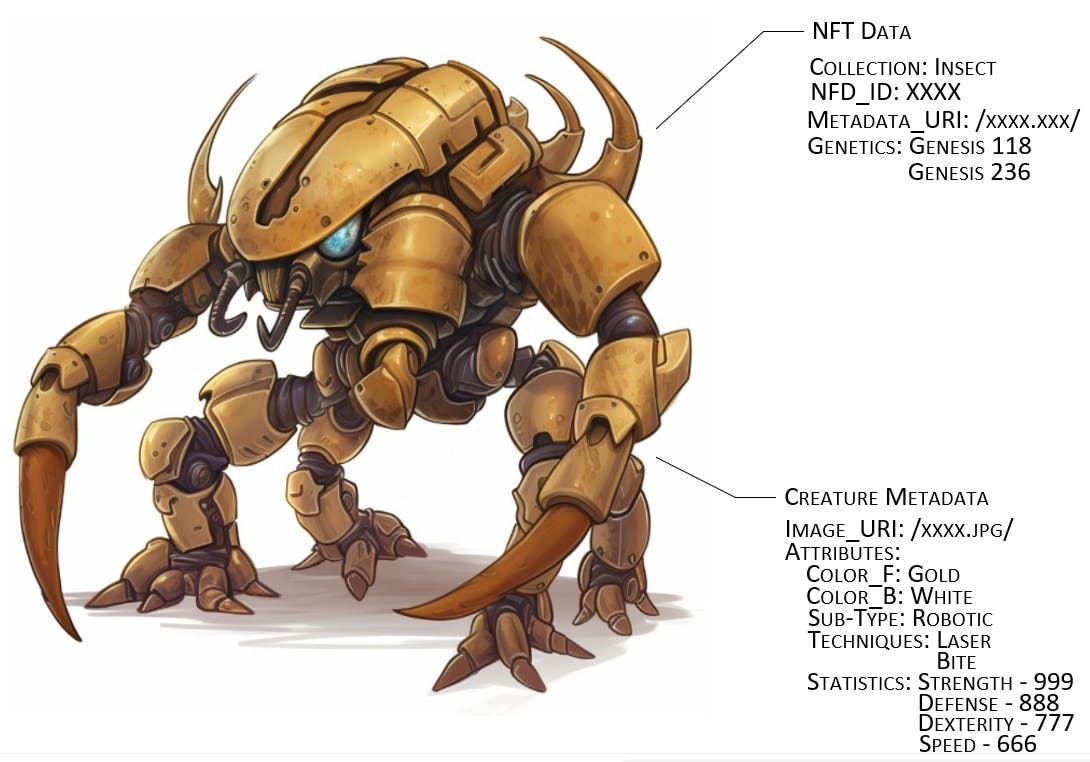
Attributes indicated in the metadata for a creature NFT may include:
Appearance: The visual characteristics of the NFT
These may include a particular image, traits or colors of an image or background, or other visual characteristics intended to represent the visual appearance of the creature
Appearance characteristics may also include a name assigned to the NFT
Available appearance characteristics for a creature may correspond to other attributes of the creature
Certain types of NFTs may be used to modify the appearance characteristics of the creature
Statistical Attributes: Each creature NFT will be associated with a set of statistical attributes that may affect the outcome of simulated battles or other activities associated with the creature, such as:
The offensive abilities of the creature’s attacks during a battle
The defensive abilities of the creature to withstand an attack
The probability for the creature to successfully perform various actions
The probability of the creature to avoid actions performed by other creatures in a simulated battle
The health or energy of the creature, which may represent the ability of the creature to continue performing certain actions. If this attribute falls below a certain level, the creature may be unusable for certain actions until the attribute is raised
Certain types of NFTs may be used to modify attributes of a creature NFT
Techniques: Each creature NFT will be associated with one or more techniques that represent actions that may be performed by the creature
A technique may represent a particular type of attack, defense, or other action that may be performed by a creature during a simulated battle
The effect of various techniques may be affected by the statistical attributes of the creature, in-game or external sources of randomness, and optionally external factors such as a number of in-game or external assets owned or spent by the wallet requesting to execute the smart contract for the technique
Certain types of NFTs may be used to add, remove, or replace techniques associated with a creature NFT
Type: Each creature will be associated with a particular species, category, or type of creature
Different types of creatures may be associated with different probabilities of various statistical attributes, access to different techniques, available appearance characteristics, etc.
The type associated with a creature is generally immutable. For example, a particular collection of NFTs, represented by a collection identifier in the NFT data for each NFT in the collection, may be associated with a species of the creatures that is not intended to change
Sub-type: Some creatures may be associated with a subspecies or subcategory
A particular type of creature may be associated at least one of multiple possible sub-types available to that type of creature. For example, sub-types may represent an element (e.g., fire, water, etc.) or concept (e.g., robotics, mutation, etc.)
Certain types of NFTs may be used to change the sub-type of a creature
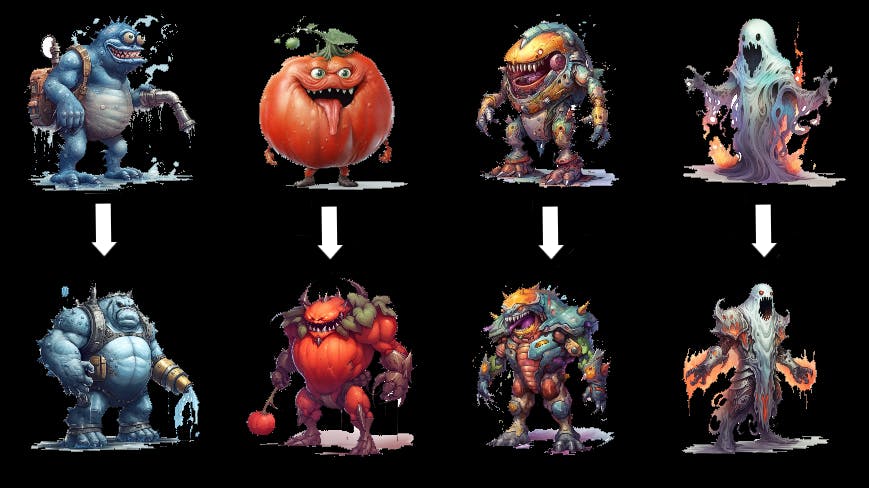
Creature Modification Process
The process to modify a creature is similar to the Egg Modification Process outlined above:
A user attempts to execute a smart contract to modify the creature
The contract verifies that the wallet requesting to execute the contract owns the creature NFT, an additional NFT (if required), and any other game requirements (if applicable) such as a cost or ownership of a quantity of other in-game assets
One or more attributes associated with the creature NFT are added, removed, replaced, increased, or decreased based on metadata associated with the additional NFT that is used, and in some cases based on in-game or external sources of randomness or other external factors
Some changes in attributes may be associated with a probability of such changes occurring rather than the changes being guaranteed to occur
Some modifications to attributes may be associated with a random range of values rather than fixed values
Modified attributes of the creature may include customizations regarding the appearance of the creature (e.g., colors, traits, backgrounds, a name), statistical attributes, techniques (e.g., adding, removing, or replacing techniques available to the creature), or changing the sub-type of the creature
Modification of a creature typically requires an additional NFT. Other types of NFTs that may be acquired and used to modify the attributes of a creature NFT may include:
Potions or other types of consumable NFTs that are destroyed (e.g., burned) when used
Equipment or other types of non-consumable (e.g., reusable) NFTs that provide modifications to attributes of the creature while owned, may be separately traded apart from the creature NFT, and cease providing modifications when no longer owned
Limited-use items that may be used a certain number of times before being destroyed
See the flowchart below:

Battling
A creature NFT may be selected to engage in a turn-based battle with one or more other creatures. Other creatures may include computer-generated opponents or creatures that are represented by NFTs owned by other players.
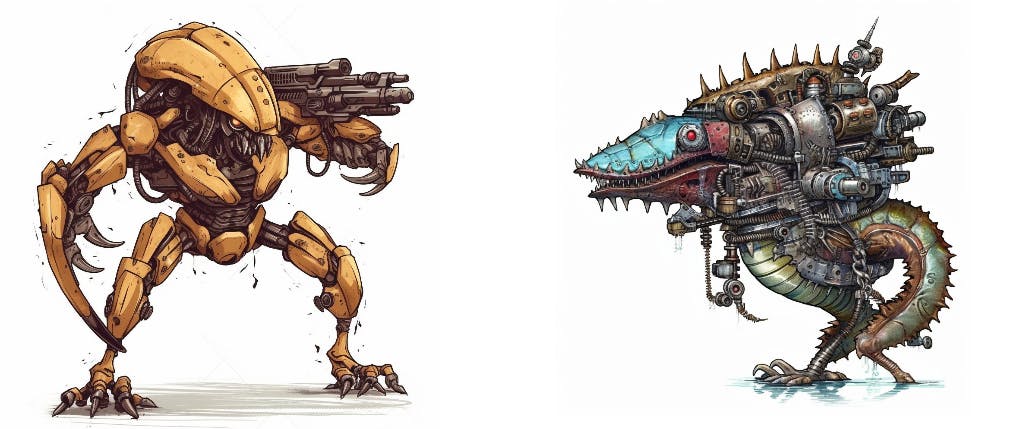
For each turn, a player may select an action associated with a creature NFT, such as a particular technique for use, an additional NFT that may be used to modify characteristics of the creature during the simulated battle, or a command to attempt to exit a simulated battle (such as a “run away” command). Some actions may be executed using smart contracts, such as using various techniques associated with a creature.
For example, execution of a smart contract associated with a technique may: 1) Verify that the wallet attempting to execute the contract owns an NFT that is associated with metadata indicating the technique; 2) Verify any other in-game requirements are met (if applicable); and 3) Determine the outcome of the technique based on the smart contract, attributes of the creature, in-game or external sources of randomness, and/or external factors.
The winner of a simulated battle may be awarded with cryptocurrency assets, such a quantity of the Beast token, described below. Creature NFTs that are used in a simulated battle may increase in value or attributes as a representation of the experience that is gained by the creature through participation in the battle.
Periodically, special battles may become available to players, such as through a “dungeon” event that includes multiple battles, battles against creatures that are more difficult or more rewarding than normal, battles against types of creatures that fit a selected theme, etc. Special rewards may be acquired through participation in these events, such as NFTs that may not be acquired through other means.
Other types of games, puzzles, or activities may similarly be undertaken using creature NFTs, with the outcomes of these activities being at least partially affected by the attributes of the creature NFT.
Breeding
Two creature NFTs owned by the same wallet may be selected for breeding, which may result in creation of a new egg NFT. The new egg NFT may have randomly-selected attributes that are based in part on the characteristics of the creature NFTs that were selected for breeding.

Breeding may have a small chance to unlock rare traits or entirely new types of creatures.
Use of the breeding mechanic may be controlled using smart contracts, similar to the egg and creature modification processes described above.
Breeding Smart Contract
A user attempts to execute the breeding smart contract
The smart contract verifies that:
The wallet requesting to execute the contract owns two creature NFTs that are able to breed
Other in-game requirements, such as a sufficient quantity of Beast tokens (described below) are owned by the wallet
A new egg NFT is generated and provided to the wallet executing the breeding smart contract
The NFT data for the new egg NFT is determined based on the NFT data associated with both creature NFTs used in conjunction with the breeding smart contract. For example, the genetic lineage for the egg NFT may be determined based on the genetic lineage of the creature NFTs selected for breeding
The NFT metadata for the new egg NFT (e.g., attributes of the egg) are determined based in part on the attributes of the creatures selected for breeding and in part using in-game or external sources of randomness. In some cases, attributes may be determined using one or more external factors (such as other assets owned or spent to augment the breeding process)
Breeding may have a small chance to unlock rare traits or new types of creatures not obtainable through other means
See the flowchart below:
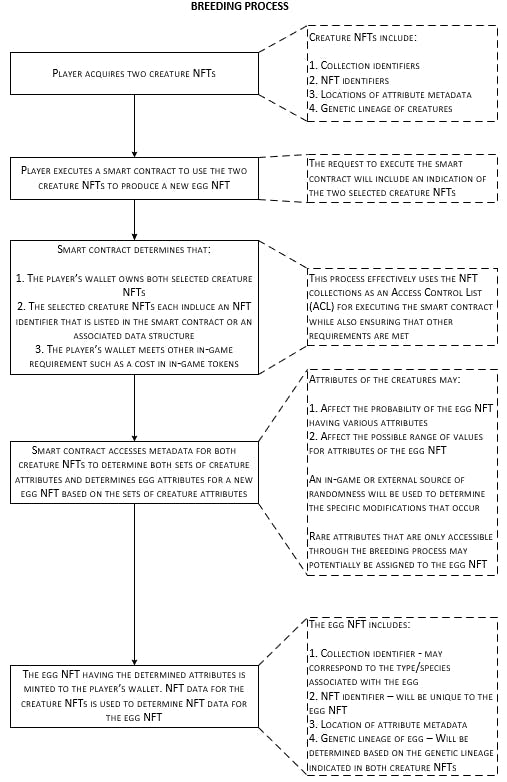
Cryptocurrency Assets
Gelotto Monsters Unleashed will use three cryptocurrency assets:
NFTs – which will represent in-game objects such as eggs, creatures, and items that may be used to modify characteristics of eggs or creatures
Beast Tokens (BEAST) – which will be used primarily as in-game currency for purchase of NFTs, participation in various activities, and may be earned through gameplay
Gelotto Tokens (GLTO)- which will be used primarily as a governance token for voting to modify parameters of the Gelotto Monsters Unleased game, and may be staked to earn BEAST tokens
Gelotto Monsters Unleashed NFTs
Each type of NFT described above may be purchased and sold by players using an in-game marketplace, where transactions use BEAST tokens. NFTs may also be bought or sold using an external NFT marketplace.
Initial Distribution
An initial supply of 1000 “Genesis” Egg NFTs, as well as various collections of modification and customization NFTs will be created as an initial set of NFTs for Gelotto Monsters Unleashed.
75% of the initial set of NFTs will be available for purchase through in-game or external NFT marketplaces
25% of the initial NFTs will be distributed to owners of various Cosmos/IBC cryptocurrency assets, Gelotto NFT collections, and selected “Blue Chip” NFT collections, as follows:
5% of the NFT airdrop allocation will be available to and divided among wallets that stake at least 250 USD in value for the following assets:
Injective (INJ)
Stargaze (STARS)
Cosmos Hub (ATOM)
Osmosis (OSMO)
Archway(ARCH)
Nois Network (NOIS)
Akash(AKT)
Celestia (TIA)
For each of the above assets, 0.625% of the airdrop allocation will be distributed, divided evenly among all qualifying wallets
- For each of the above assets, an additional 0.3125% of the airdrop allocation will be divided evenly among all qualifying wallets that stake the required amount using Gelotto validators
5% of the NFT airdrop allocation will be available to and divided among wallets that provide liquidity having a value of at least 250 USD in the following liquidity pools associated with Cosmos/IBC assets:
Osmosis DEX Pool 1 (ATOM/OSMO)
Osmosis DEX Pool 604 (STARS/OSMO)
Osmosis DEX Pool 2 (ION/OSMO)
Osmosis DEX Pool 725 (INJ/OSMO)
Osmosis DEX Pool 1248 (TIA/OSMO)
Osmosis DEX Pool 1093 (AKT/OSMO)
Osmosis DEX Pool 1281 (ETH/OSMO)
Osmosis DEX Pool 1574 (GLTO.INJ/OSMO)
Osmosis DEX Pool 790 (GKEY/OSMO)
Osmosis DEX Pool 1630 (BEAST/OSMO)
For each of the above liquidity pools, 0.5% of the airdrop allocation will be distributed, divided evenly among all qualifying wallets
- For each of Osmosis DEX Pool 1574(GLTO.INJ/OSMO), Osmosis DEX Pool 790 (GKEY/OSMO), and Osmosis DEX Pool 1630 (BEAST/OSMO), an additional 0.333% of the airdrop allocation (3,333,333 tokens) will be divided evenly among all qualifying wallets
5% of the NFT airdrop allocation will be available to wallets that hold the following from Gelotto NFT collections:
At least 3 Gelotto Series 1 NFTs
At least 3 Gelotto Series 2 NFTs
At least 3 Gelotto Series 3 NFTs
At least 3 Mostro del Gelotto NFTs
At least 3 Cream Queens NFTs
- 5% of the NFT airdrop allocation will be available to wallets that hold NFTs from the following Blue Chip NFT collections:
Bad Kids
Women-from-Cosmos Kids
The WadSquad
The Watchers, Protectors of the Interchain
PENDING
The airdrop for the initial set of NFTs will be performed using a randomized raffle process. A wallet will receive a raffle entry for each airdrop requirement that is met. Winning raffle entries will then be selected randomly.
NFT Uses
Gelotto Monsters Unleashed NFTs may be:
Purchased through an in-game or external NFT marketplace
Sold or auctioned through an in-game or external marketplace
Used to participate in various in-game activities, such as simulated battles. Some activities may require payment of BEAST tokens to participate, and some activities may reward BEAST tokens for participation or winning
Two creature NFTs may be used to create a new egg NFT through the breeding process. Breeding will require a cost in BEAST tokens
Egg and creature NFTs will retain metadata that associates them with the original Genesis NFT from which they were bred. When a creature or egg NFT is sold, the current owner of a Genesis creature from which the sold creature or egg has descended will receive a percentage of the sale price (see below)

Genesis Egg NFTs
The NFT data for an egg or creature NFT may include an indication of the egg’s genetic lineage. The first 1000 egg NFTs created for use in the Gelotto Monsters Unleased game will have data indicating that these NFTs are “Genesis” NFTs. Because the underlying NFT remains unchanged when the eggs are modified, hatched to generate creatures, and the creatures are modified, the “Genesis” status of the NFTs will remain throughout their existence.
When a new egg NFT is created using the breeding smart contract, the NFT data indicating the genetic lineage for the newly-generated egg NFT will be determined based on the genetic lineages of the creature NFTs used in the breeding process. Therefore, the Genesis NFTs from which a future egg or creature is descended will be able to be determined based on the NFT data for that NFT. A newly-generated NFT may be descended from multiple Genesis NFTs.
The owner of a Genesis NFT will receive a royalty when any egg NFT or creature NFT that is descended from that Genesis NFT is traded. Specifically, a portion of the transaction price to purchase the egg or creature NFT will be provided to the wallet(s) that own a Genesis NFT from which the traded NFT has descended. If a traded egg or creature NFT is descended from multiple Genesis NFTs, this portion of the purchase price will be divided equally among each Genesis NFT from which the traded NFT is descended.
Initially, 3% of the transaction price associated with a traded egg or creature NFT will be provided to the owner(s) of the Genesis NFT(s) indicated in the genetic lineage of the traded NFT. This amount may be modified through governance.
Beast Token (BEAST)
The BEAST token will function as the primary in-game currency for Gelotto Monsters Unleashed, and may be earned and spent through participation in various in-game activities.

Initial Distribution (WIP)
The BEAST token will have a maximum supply of 1,000,000,000 tokens.
55% of the BEAST token supply (600,000,000 tokens) will be earned in game via various activity:
Rewards for achieving certain milestones, participating in special events, and leaderboard rankings
Rewards for completing daily and weekly quests
Earn in PVP battles & large scale war (Battlegrounds)
10% of the BEAST token supply (150,000,000 tokens) will be distributed by airdrop as follows:
2.5% (25,000,000 tokens) divided among wallets that stake at least 250 USD in value for the following assets:
Injective (INJ)
Stargaze (STARS)
Cosmos Hub (ATOM)
Osmosis (OSMO)
Archway(ARCH)
Nois Network (NOIS)
Akash(AKT)
Celestia (TIA)
- For each of the above assets, 0.3125% of the airdrop allocation (3,125,000 tokens) will be distributed, divided evenly among all qualifying wallets
2.5% (25,000,000 tokens) divided among wallets that provide liquidity having a value of at least 250 USD in the following liquidity pools associated with Cosmos/IBC assets:
Osmosis DEX Pool 1 (ATOM/OSMO)
Osmosis DEX Pool 604 (STARS/OSMO)
Osmosis DEX Pool 2 (ION/OSMO)
Osmosis DEX Pool 725 (INJ/OSMO)
Osmosis DEX Pool 1248 (TIA/OSMO)
Osmosis DEX Pool 1093 (AKT/OSMO)
Osmosis DEX Pool 1281 (ETH/OSMO)
Osmosis DEX Pool 1574 (GLTO.INJ/OSMO)
Osmosis DEX Pool 790 (GKEY/OSMO)
Osmosis DEX Pool 1630 (BEAST/OSMO)
For each of the above liquidity pools, 0.25% of the airdrop allocation (2,500,000 tokens) will be distributed, divided evenly among all qualifying wallets
For each of Osmosis DEX Pool 1574(GLTO.INJ/OSMO), Osmosis DEX Pool 790 (GKEY/OSMO), and Osmosis DEX Pool 1630 (BEAST/OSMO), an additional 0.333% of the airdrop allocation (3,333,333 tokens) will be divided evenly among all qualifying wallets
2.5% (25,000,000 tokens) to wallets that hold the following from Gelotto NFT collections:
At least 3 Gelotto Series 1 NFTs
At least 3 Gelotto Series 2 NFTs
At least 3 Mostro del Gelotto NFTs
At least 3 Cream Queens NFTs
2.5% (25,000,000 tokens) to wallets that hold NFTs from the following Blue Chip NFT collections:
Bad Kids
Women-from-Cosmos Kids
The WadSquad
The Watchers, Protectors of the Interchain
PENDING
5% of the BEAST token supply(100,000,000) will be distributed as staking rewards to users who stake GLTO tokens
10% of the BEAST token supply (100,000,000) will be distributed as liquidity incentives to users that provide liquidity to selected liquidity pools that enable the exchange of BEAST tokens with other assets
2.5% of the BEAST token supply (25,000,000) will be set aside for community incentives, events, and promotions
10% of the BEAST token supply (100,000,000) will be allocated to the development team for Gelotto Monsters Unleashed
- Tokens allocated to the team will be subject to a vesting schedule that includes an initial lock-up period and a gradual release of tokens over time
1.5% of the BEAST token supply (25,000,000) will be allocated for marketing incentives and strategic partnerships
- These tokens may be used to increase awareness of Gelotto Monsters Unleashed, attract new users, and establish collaboration with other projects or companies that may contribute to the growth and success of the game
5% of the BEAST token supply (50,000,000) will be allocated to a community treasury
Use of the treasury will be governed by users who stake the GLTO token
The purpose of the treasury will be to fund future initiatives, improvements, and community-driven projects
Stakers of the GLTO token may submit proposals and vote on the allocation of tokens from the community treasury
Tokens from the treasury may also be used as funds for adjustments to the in-game economy, distributions, or other aspects of the project that may require intervention to maintain stability and success
Beast Token Uses
BEAST may be spent to:
Purchase in-game assets, such as egg or creature NFTs, potion NFTs, or other types of NFTs to modify creatures or eggs
NFTs may be available through the game platform itself, such as by minting a new NFT or purchasing an NFT from an in-game marketplace
NFTs may also be purchased from other players, either through the in-game marketplace or external NFT marketplaces
A portion of the sale price of a creature or egg NFT will be provided to the current owner(s) of the Genesis creatures from which the purchased creature or egg descended
Breed NFTs. A cost in BEAST tokens will be associated with breeding of creature NFTs to control the rate at which new egg NFTs are created
Modify egg and creature NFTs
A cost in BEAST tokens may be associated with use of potion NFTs or other types of NFTs that change the attributes of an egg or creature NFT
Some NFTs may be used to modify the characteristics of an egg or creature NFT without a cost in BEAST tokens
In some cases, BEAST tokens may also be spent to improve the attributes of a creature NFT without requiring an additional NFT
Participate in simulated battles or other activities
Participation in certain battles or other activities may require payment of a selected amount of BEAST tokens
Participation in some activities may not require payment of BEAST tokens
BEAST tokens may also be staked in association with a selected creature NFT
- Staking BEAST tokens in association with a creature NFT may increase the attributes of a creature while the tokens are staked, or provide improvements to particular techniques or performance in various activities
BEAST may be acquired by:
Participating in game activities
Example: at the conclusion of a simulated battle, the winning player will be awarded BEAST tokens
Some activities may result in players receiving BEAST tokens for participation, independent of the outcome of the activity
Selling NFTs
Egg, creature, and modification NFTs may be sold through an in-game marketplace for BEAST tokens
NFTs may also be sold by players through external marketplaces
Providing liquidity. Liquidity providers who provide liquidity in liquidity pools that enable the exchange of BEAST tokens with other assets will receive BEAST tokens as incentives
Staking GLTO tokens. Users who stake GLTO tokens on the Gelotto platform will receive BEAST tokens as incentives
Purchasing BEAST from liquidity pools that enable the exchange of BEAST tokens with other assets
Owning a Genesis NFT at a time when other NFTs descended from the Genesis NFT are traded
Gelotto Token (GLTO)
The GLTO token is the primary token for governance and gameplay on the Gelotto platform. The GLTO token was distributed to holders of various Cosmos/IBC assets in June of 2022. GLTO tokens may be used to play various games, and to stake and play the role of “the house” against which games are played. Staked GLTO tokens also enable participation in governance of the Gelotto platform, which includes governance of the Gelotto Monsters Unleased game.

GLTO may be spent to:
Participate in various games on the Gelotto platform
Staked GLTO may be lost if games against the house are won by players
GLTO may be acquired by:
Participating in various games on the Gelotto platform
Providing liquidity. Liquidity providers who provide liquidity in liquidity pools that enable the exchange of GLTO tokens with other assets will receive GLTO tokens as incentives
Purchasing GLTO tokens from liquidity pools that enable the exchange of GLTO tokens with other assets
Stakers of GLTO may earn GLTO tokens as revenue if games against the house are lost by players
Tokenomics
The multiple uses associated with Gelotto Monsters Unleashed NFTs, BEAST tokens, and GLTO tokens, coupled with costs to create and modify NFTs, removal of portions of the BEAST token from circulation, and incentives to hold and stake game assets, are intended to provide value to these assets, as described below.
Utility
The use cases for BEAST and GLTO tokens are intended to provide value to these assets. For example, BEAST may be spent to purchase game assets or to participate in many in-game activities, may be staked to improve the performance of activities associated with a creature NFT, or may be spent to improve the attributes of a creature NFT or create new NFTs through the breeding smart contract. These in-game uses of BEAST are intended to at least partially offset the earning of BEAST tokens through gameplay, providing liquidity for the BEAST token, and staking GLTO tokens, and the corresponding sale of BEAST tokens.
Similarly, because GLTO may be staked to earn BEAST tokens, used for governance, and has other uses on the Gelotto platform, the addition of Gelotto Monsters Unleashed to the Gelotto platform may add additional utility to the GLTO token.
Deflationary and Value-Capturing Measures
Each time that a transaction using BEAST tokens occurs, a portion of the BEAST tokens associated with the transaction may be removed from circulation to at least partially offset the increasing supply of available BEAST tokens caused by earning through gameplay, staking incentives, and liquidity pool incentives. Initially, 3% of each transaction cost will be removed from circulation, but this amount may be modified through governance.
BEAST tokens that are removed from circulation may be burned or distributed to collective wallets for other purposes. For example, each time that a transaction using BEAST tokens occurs, 1% may be burned, 1% may be transferred to the Gelotto Grand Prize Game wallet, and 1% may be transferred to the Gelotto VIP Incentives wallet.
In addition to the reduction in circulation described above, each time that an NFT is traded, a 10% royalty will be applied to the transaction. Royalties may be transferred to various Gelotto special-purpose wallets, as described above, removing BEAST tokens from circulation. In cases where the traded NFT includes a creature or egg NFT, a portion of this royalty (initially 3%) may be provided to the owner(s) of the Genesis NFTs indicated in the genetic lineage of the traded NFT.
Conclusion
Gelotto Monsters Unleased will aim to provide an engaging, sustaining, and potentially profitable gaming experience to players using the blockchain. With a focus on collecting, modifying, breeding, and battles associated with creatures represented by NFTs, the game is planned to offer a rich and immersive experience with innumerable ways to customize NFTs and explore different gameplay strategies. The inclusion of a variety of potions and techniques, also represented by NFTs, that may be used to modify creature NFTs, may promote a sense of discovery and experimentation among players.
Use of smart contracts and metadata to represent changeable attributes of eggs and creatures, while NFTs themselves are used to record immutable data such as genetic lineage, enables selected data to be carried forward throughout the existence of a creature, and further enables a collection of NFTs to be used as an ACL to determine authorization to execute smart contracts.
Numerous uses for the in-game BEAST token, coupled with removing portions of transacted tokens from circulation and use of royalties when NFTs are traded, may facilitate the sustainability of the in-game economy by controlling the ingress and outflow of tokens.


